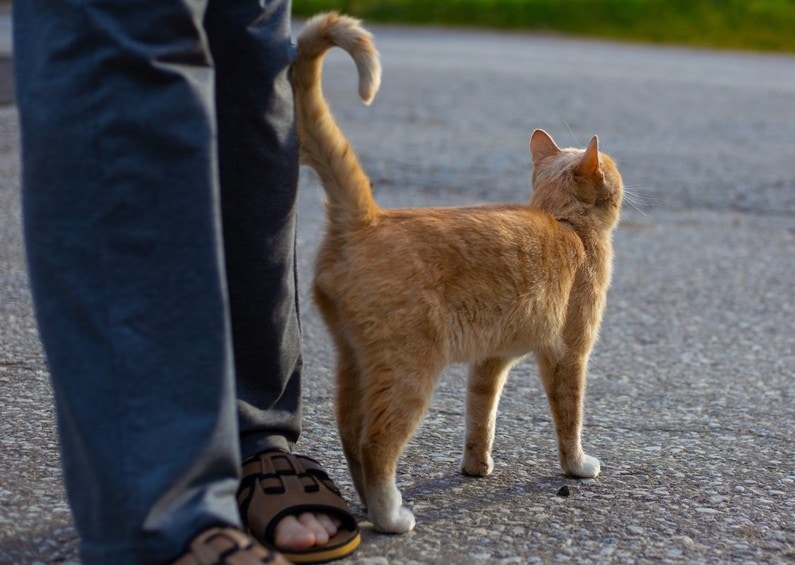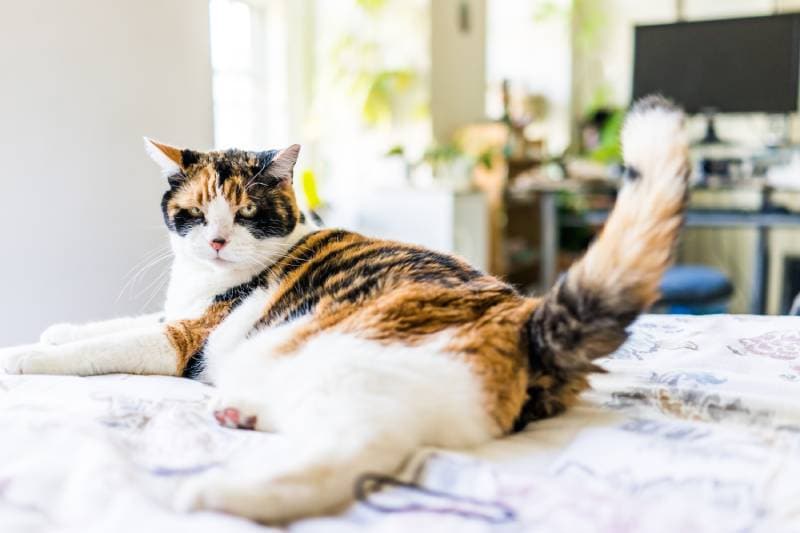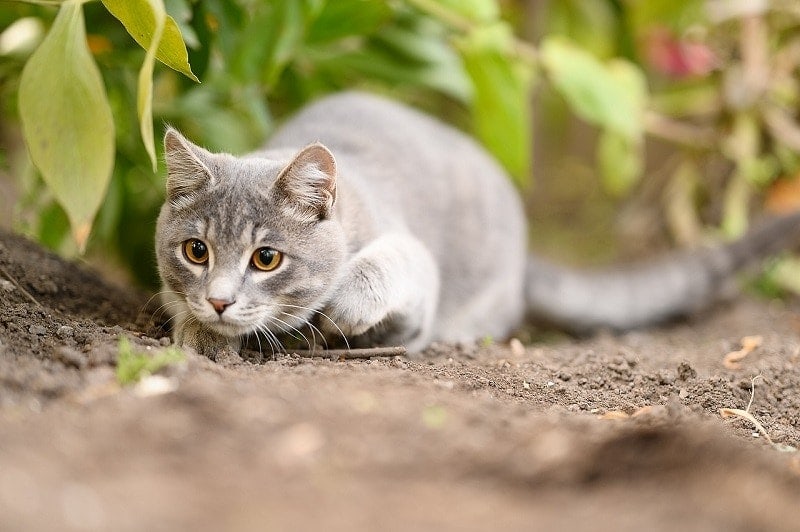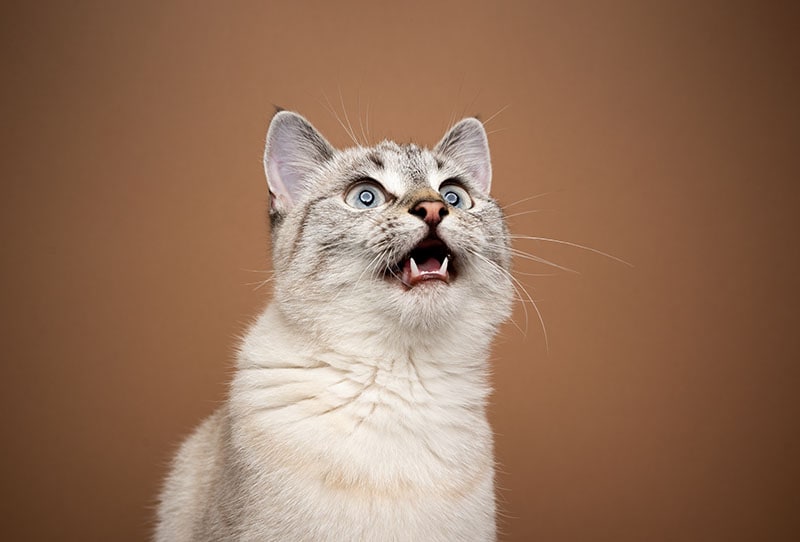
Cats do not wag their tails like dogs do, but they do shake their tails. Cats twitch and swish and shake their tails for a variety of different reasons. Learning the subtle differences between a cat’s tail position and movements can tell you a lot about how your cat is feeling and what they are doing. Cats shake their tails in a number of different situations, and each one is a little different. Here are nine reasons why cats shake their tails, what each means, and how it looks.
The 9 Reasons Why Cats Shake Their Tails
1. The Cat Is Happy
A happy cat will shake their tail in a very noticeable way. The tail will be loose and relaxed. The shake will go all the way through the tail from the base to the tip. The cat might also run their tail across something. If your cat loves you or is feeling affectionate, they might even wrap their tail around your legs or rub their tail against you, as well as head butting you and purring. A happy cat’s tail is usually upright and bent. A happy tail tells you that it is safe to approach the cat and that the cat is content.

2. The Cat Is Anxious
The term scaredy-cat is colloquial for a reason. Cats can be skittish and anxious. It should come as no surprise that they will shake their tails when they are feeling this way. An anxious cat will shake their tail and then lower it to the ground. A low tail that shakes slowly is a sign that your cat is feeling skittish. Watch for the tip of the tail to be pointed toward the ground and for the tail to be low. They may also be crouched down and have their ears pinned back. An anxious cat is unsure of their surroundings or situation, and you should be careful around them.
3. The Cat Is Agitated
When a cat is agitated, they will give a very distinctive shake of their tail. The flick or the low flick is a telltale sign that a cat is annoyed, irritated, or agitated. The cat can be lying down or standing when they give their tail a very sharp and short shake. Usually, the tip or the top third will shake. This is an outward sign to people or other cats that they are not in the mood to play or be messed with. An agitated or irritated cat can quickly turn into an aggressive cat in the wrong situation. If you see an agitated cat, it is a good idea to leave them alone. Many times, the cat will get over their bad mood on their own, but annoying them or messing with them when they are agitated can make the situation worse.

4. The Cat Is Aggressive
An aggressive cat will shake their tail in two distinctive ways. First, an aggressive cat will have their tail straight in the air. No kinks, no bends. A tail that is straight up in the air and quivering is a sign to stay away and leave them alone. This is a sign that the cat is about to hiss, puff up, or even attack.
The other way a cat will shake their tail is by whipping it or sweeping it. This is especially true if the cat is already showing signs of agitation or irritation. As we said, an agitated cat can turn into an aggressive cat in moments. If you see a cat that is sweeping their tail and perhaps hissing with a tense body position, give them a wide berth. Approaching a cat like this can leave you with a scratch or bite wounds.
5. The Cat Is Hunting
Cats will shake their tails when they are hunting. This is an involuntary response to the energy and excitement that runs through a cat’s body during a hunt. You can see a cat get really low to the ground, their pupils will dilate, and their tails will start to shake. You can often see this telltale shake right before the cat pounces or takes off after their prey. Unless you somehow find yourself in the path of a wild tiger or leopard, cats should never be hunting you so sit back and enjoy the show.

6. The Cat Is Playing
Playful cats will swish and twitch their tails when they are playing. Playing is very similar to hunting, and the same parts of the brain are activated when they are hunting and playing. You can see a cat’s tail shaking during play when they are up on their hind legs or low to the ground about to pounce on a toy. Playful twitching is fast and jerky. You can tell when a cat is playing thanks to their dilated pupils and their twitching tails. A playful cat is often a happy cat.
7. The Cat Is Excited
An excited cat’s tail will stand up and quiver just at the tip. Many cats will do this when they see you. This behavior is especially prominent when you come home from work or wake up in the morning, again it might be combined with head butting you and purring. This is a classic tell that your cat is excited, and it usually is directed at their owner or another cat. If you see this type of shake when you first see your cat after some time apart, you should give your cat some love and attention. They are excited to see you!
If a cat’s tail is straight up and quivering while your cat is backed up to a vertical surface such as a wall, they may also be urine marking, but this will usually be obvious!

8. The Cat Is Scared
A cat will shake its tail when they are scared. This is often accompanied by the cat’s tail puffing up. A cat will puff themselves up to make them look bigger when they are scared. The tail can grow especially large when a cat is afraid. After the tail expands, the cat will shake it to make them look more intimidating. This is a ploy to try to scare away anything that is scaring the cat. Sometimes you will see the sweeping shake while the tail is puffed up. A scared cat can take two options, fight or flight. A scared cat might bolt off and run away from you, but they also might decide to hunker down and attack.
9. The Cat Is Sleeping
Sometimes a cat’s tail will swish and shake in their sleep. If you spot your cat’s tail twitching or shaking in their sleep, they could be dreaming. It could also just be an involuntary motion that occurs when the cat is snoozing soundly. We move a lot in our sleep, and cats have the same potential to move around while their eyes are closed. If you see your cat’s tail swishing or shaking in their sleep, it is nothing to worry about.

Watch the Cat’s Tail Position
A cat’s tail can be a weathervane that tells you which way the wind is blowing with your cat. A cat’s tail is a very visible sign of their mood and disposition. You can learn a lot by watching a cat’s tail. Learning how a cat’s tail is connected to their mood can help you determine your cat’s next actions and behaviors. This can be crucial to avoiding making your cat agitated or tipping them towards aggression.
Learning these signs and actions can help give your cat love when they are affectionate, or they can help you avoid an aggressive cat that you might stumble on while walking around outside.
Conclusion
Cats shake their tails for a number of different reasons. They can shake their tails when they are excited, when they are agitated, and when they are feeling affectionate. Each shake looks a little different, and you can learn a lot by watching your cat’s tail shake and matching it up with the context, position of the tail and other body language cues. Reading a cat’s body language can help protect you from an ornery cat, and it can help you better bond with your pet.
See Also:
- Can Cats Eat Green Beans? Vet Reviewed Benefits Explained
- Why Does My Cat Wink? Vet-Approved Possible Reasons & FAQ
Featured Image Credit: Natalya Kokhanova, Shutterstock







